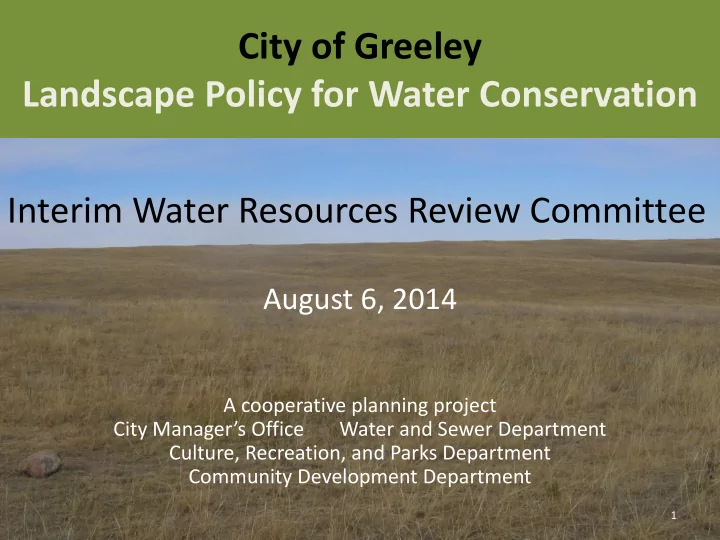

City of Greeley Landscape Policy for Water Conservation Interim Water Resources Review Committee August 6, 2014 A cooperative planning project City Manager’s Office Water and Sewer Department Culture, Recreation, and Parks Department Community Development Department 1
Conservation and Efficiencies • Lawn watering restrictions since 1907 – progressive if drought, sent out “water cops” during 2002 - 2003 drought, asked to stop watering Oct. 1, 2012 • Lawn planting restrictions and water waste ordinance • Toilet, clothes washer, and irrigation efficiency rebate – 800 per year • Residential and commercial water efficiency audits – more than 200 per year • Water efficiency retrofits – 250 showerheads exchanged in 2013 and 394 0.8 gpcd toilets in apartment complex in 2012
Conservation and Efficiencies • Informational Water Budget – bill provides information based on residential irrigable area and weather, specifically recognized in draft Colorado Water Plan • Park and Golf Course Water Budgets – provide information weekly on water demands and monitor usage, restrict during droughts • Water Loss Control – Cement line old cast iron pipes • Education and Information – Targeted communication, water festivals, bill stuffers, advertisement, social media etc. • Coordinate water c onservation with City Manager’s office, water department, parks, and community development
Results • Greeley’s population increased 40% since 1990, while demand remained constant. • Since 2002, per capita demand has dropped more than 20%.
Per-Capita Demand for Water Has Dropped Reductions in Estimated Water Demand 100,000 250,000 Because of universal metering and water conservation, water demand will no longer match population growth. Water Demand (ac-ft) Census Population 80,000 200,000 60,000 150,000 40,000 100,000 20,000 50,000 Historic Demand 0 0 1910 1930 1950 1970 1990 2010 2030 2050 5
Water Demand Reduction • Improving efficiency has been our focus – Metering – Lawn watering restrictions – Soil amendment requirements for new lawn – Toilet rebates – Irrigation audits – Commercial audits – Education – Leak detection – City parks and facilities use of water budget – Reusing all legally available water – Implementing the water budget • Remaining opportunity is water conservation by reducing water used for landscape irrigation. 6
Native plants like blue gramma, rabbitbrush, and sand cherry don’t need irrigation 7
Why not just native plants? 2013 survey of residents – 56% wanted better infrastructure including parks – 59 % wanted better community appearance 8
Number of plant species in Greeley’s database that grow in each hydro-zone Full water use does not add that many more plants 9
Possible Ways to Implement • Land Use Intensity Alternative Irrigation Demand Landscape design achieves water reduction • Capital Investments • Technology • Training • Incentives • Regulations 10
Land Use Intensity Land Use Intensity • Higher density neighborhoods use less water per capita for irrigation • Dense cities can reduce irrigated turf areas and still support a healthy urban forest • Green infrastructure can allow water to infiltrate and reduce evaporation • Taller buildings can shade adjacent buildings and streets 11
Capital Investment • Convert landscapes in park areas not needed for athletic fields from heavily irrigated turf to lower water landscapes • Use low water landscaping principles for street ROW landscaping • Conversion of City facilities, HOA areas, and large commercial sites 12
Irrigation and computer technology improves irrigation efficiency • Technology is constantly evolving • Goal of irrigation is adequate soil moisture – Soil moisture sensors – Precipitation gauges • New controllers driven by soil moisture and precipitation sensors • Irrigation heads that reduce evaporation loss and deliver water more evenly • Drip systems 13
Education and Technical Assistance • Provide sample layouts; provide a plant database by water demand • Maintain detailed “how - tos” for lay people on best practices • Provide training to landscape professionals, homeowners, and property managers • Provide information on best practices 14
Incentives • Consider providing low/no interest financing for water conserving landscapes • Consider a rebate program for replacing obsolete irrigation heads and controllers with efficient ones • Consider reducing water dedication requirements when developers commit to water-saving landscapes 15
Regulations • Require water efficient landscape design and irrigation for new and replacement landscapes • Require saving of topsoil for new construction and soil conditioning for all landscapes prior to landscape installation • Reduce minimum sizes for trees installed in water conserving landscapes 16
Conclusion • Greeley has a long history of water conservation, and has an approved CWCB conservation plan. • Responsible demand management has already produced significant results. • Continued dramatic declines in per capita usage may not be realistic. • Municipal providers can and do innovate to conserve water while meeting the needs of residents and businesses. Local control works.
Thank You Questions? 18
Recommend
More recommend